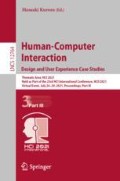Abstract
One of the most crucial steps to becoming independent for young people is leaving their parents’ homes to study or get a decent job. Based on the current population reports, 4,208,601 young people from 20–24 leave their parents’ house to live independently. When Young adults start their higher education or employment by living independently, they face many challenges with housekeeping specialty pest control. In this study, researchers tried to help young adults who move to a new place to start their higher education or employment to share their pest control experiences, access updated local information, and communicate better by designing a communication-based platform application. Community-based applications consist of one or many forums in which each member could be involved in the community.
Access this chapter
Tax calculation will be finalised at checkout
Purchases are for personal use only
References
Home Team Pest Deafense “Survey Results on Pests”: https://pestdefense.com/hometeam-releases-survey-results-on-pests/. Accessed 24 Apr 2012
Centers for Disease Control and Prevention and U.S. Department of Housing and Urban Development: Healthy housing reference manual, Chapter 4. US Department of Health and Human Services, Atlanta (2006)
Murphy, R.G., Todd, S.: Minimizing pest risk in dwellings. Struct. Surv. 14(1), 9–13 (1996). https://doi.org/10.1108/02630809610116197
Bateman, P.L.G.: Household pests. Struct. Surv. 2(2), 115–123 (1984). https://doi.org/10.1108/eb006181
Parkman, K.: Pest control statistics and trends. https://www.consumeraffairs.com/homeowners/pest-control-statistics.html. Accessed 14 May 2020
Pélissié, B., Crossley, M.S., Cohen, Z.P., Schoville, S.D.: Rapid evolution in insect pests: the importance of space and time in population genomics studies. Curr. Opin. Insect Sci. 26, 8–16 (2018)
Triwidodo, H., Mudikdjo, K., Panjaitan, N.K., Manuwoto, S., Yuliani, T.S.: Studies on the behavior housewives in home pesticide usage in Special Capital Region Jakarta. IPB (Bogor Agricultural University (2012). https://repository.ipb.ac.id/jspui/handle/123456789/54270
Armes, M.N., et al.: Residential pesticide usage in older adults residing in Central California. Int. J. Environ. Res. Public Health 8, 3114–3133 (2011). https://doi.org/10.3390/ijerph8083114
Savage, E.P., et al.: Household pesticide usage in the United States. Arch. Environ. Health 36, 304–309 (1981). https://doi.org/10.1080/00039896.1981.10667642
Stout II, D.M., et al.: American Healthy Homes Survey: a national study of residential pesticides measured from floor wipes. Environ. Sci. Technol. 43, 4294–4300 (2009). https://pubs.acs.org/doi/full/10.1021/es8030243
World Health Organization: The WHO Recommended Classification of Pesticides by Hazard and Guidelines to Classification 2009, p. 8. World Health Organization (2010). https://apps.who.int/iris/bitstream/handle/10665/44271/9789241547963_eng.pdf?sequence=1
Den Hond, F., Groenewegen, P., van Straalen, N.: Pesticides Problems, Improvements, Alternative, pp. 1–17. Blackwell Sciences Ltd., Blackwell Publishing company (2003)
Raini, M., Isnawati, A., Herman, M.J.: Paparan propoxur pada anggota rumah tangga yang menggunakan anti serangga semprot di Jakarta, Tangerang, Bekasi dan Depok. Indonesian Bull. Health Res. 37, 43–54 (2009). https://doi.org/10.22435/bpk.v37i1
Atkinson, H.C., Begg, E.J., Darlow, B.A.: Drugs in human milk. Clinical pharmacokinetic considerations. Clin. Pharmacokinet. 14, 217–240 (1988). https://doi.org/10.2165/00003088-198814040-00003
Hileman, B.: The environment and Parkinson’s: If exposure to chemicals causes this dread disease, regulators may have to alter approaches to neurotoxicity testing and risk assessment. Chem. Eng. News. 79, 35–37 (2001). https://doi.org/10.1021/cen-v079n038.p035
Bradman, A., Whyatt, R.M.: Characterizing exposures to nonpersistent pesticides during pregnancy and early childhood in the National Children’s Study: a review of monitoring and measurement methodologies. Environ. Health Prospect 113, 1092–1099 (2005). https://doi.org/10.1289/ehp.7769
Coronado, G.D., Vigoren, E.M., Thompson, B., Griffith, W.C., Faustman, E.M.: Organophosphate pesticide exposure and work in pome fruit: evidence for the take-home pesticide pathway. Environ. Health Prospect 114, 999–1006 (2003). https://doi.org/10.1289/ehp.8620
Steer, C.D., Grey, C.N.B., Alspac Study Team: Socio-demographic characteristics of UK families using pesticides and weed-killers. J. Expo. Sci. Environ. Epidemiol. 16, 251–263 (2006). https://doi.org/10.1038/sj.jea.7500455
Kaplan, K.: Learning What “Wood” a Termite Prefers. https://www.ars.usda.gov/news-events/news/research-news/2015/learning-what-wood-a-termite-prefers/. Accessed 12 Nov 2015
Collage affordability: Working at the Minimum Wage. http://collegeaffordability.urban.org/covering-expenses/working-during-college/#/. Accessed 10 May 2016
Daniel, W.: How much does pest control service cost? https://homeguide.com/costs/pest-control-prices. Accessed 18 Mar 2020
U.S Bureau of Labor Statistics: Time use on average weekly for full time university and college students. https://www.bls.gov/tus/charts/students.htm. Accessed 20 Dec 2016
Delgado, M.: Social Work Practice in Nontraditional Urban Settings. Oxford University Press (1999)
Kazmi, S.S.: Create Community Based Mobile Apps. https://appsgeyser.com/blog/create-community-based-mobile-apps/. Accessed 8 Jul 2020
Author information
Authors and Affiliations
Corresponding author
Editor information
Editors and Affiliations
Rights and permissions
Copyright information
© 2021 Springer Nature Switzerland AG
About this paper
Cite this paper
Jahani, S., Harivand, R.G., Sohn, J.J. (2021). Learn and Share to Control Your Household Pests: Designing a Communication Based App to Bridge the Gap Between Local Guides and the New Users Looking for a Reliable and Affordable Pest Control Solutions. In: Kurosu, M. (eds) Human-Computer Interaction. Design and User Experience Case Studies. HCII 2021. Lecture Notes in Computer Science(), vol 12764. Springer, Cham. https://doi.org/10.1007/978-3-030-78468-3_4
Download citation
DOI: https://doi.org/10.1007/978-3-030-78468-3_4
Published:
Publisher Name: Springer, Cham
Print ISBN: 978-3-030-78467-6
Online ISBN: 978-3-030-78468-3
eBook Packages: Computer ScienceComputer Science (R0)

